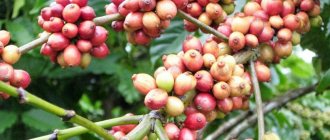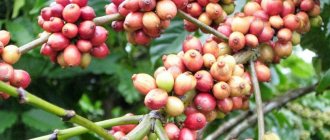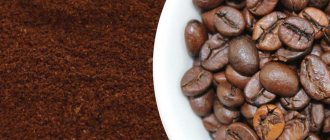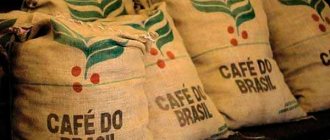1
Leave a plus!
Don’t want to make a mistake when choosing a coffee mixture to prepare an aromatic drink in an Italian Moka coffee maker? Then read this material!
We are so loyal to our favorite brands when buying coffee for the coffee maker that we often don’t even notice the variety of offers from different brands lined up on supermarket shelves. No matter how many bright and beautiful packages with aromatic mixtures stand near our favorite manufacturer, we stubbornly buy the usual packaging, you must agree.
Have you ever wondered if you are overpaying? Perhaps among Italian manufacturers there are those that offer equally high-quality products at a lower price. Or, perhaps, by ignoring other manufacturers, you are denying yourself the more intense pleasure of a cup of coffee? Let's figure it out together with the number 1 experts in Italy, tasters of the gastronomic newsletter “Dissapore”.
So, the experts purchased coffee from 10 of the most famous Italian brands, choosing classic versions of the drink from each company. To be very clear: the experts were comparing mixtures that were advertised on the packaging to be of equal quality. Let's see what comes of it.
Kimbo
Looking ahead, we note that the much-hyped Kimbo coffee was an absolute disappointment for experts. The aroma and richness were below average; moreover, the coffee tasted too sour.
The experts, not trusting the initial results, decided to try a package purchased from another supermarket, but the result was similar.
But the label entices with promises and says: “Classic mixture. Sweet and fragrant." Composition: 70% Arabica, 30% Robusta.
Final judgment: inexpensive, but tasteless.
Rating: 5
Price per kg: 10.74 euros.
Caffè Mauro
The coffee we drink at the bar has a high percentage of Arabica in the blend; As a rule, the Arabica/Robusta ratio in a bar mixture is about 80% and 20%.
As for the Caffè Mauro we tested, the opposite is true: the blend contains 70% Robusta, so this brand is usually considered second-rate. Coffee from this mixture turns out less rich and aromatic.
What do we want to say? The second-rate coffee tasted more pleasant than the first-rate Kimbo. The coffee delivers a nice dried fruit flavor on the palate and the astringency of the drink is at more or less the right level (astringency is the dry sensation you feel in the mouth).
This is coffee with average quality characteristics or, more correctly, slightly above average.
Rating: 6
Price: 10.89 euros per kg.
Types of Italian coffee
When talking about Italian coffee, everyone imagines a tiny portion of strong and aromatic espresso and you won’t be mistaken. This drink is first on the list of national drinks. But there is no limit to perfection. In this country there is double and triple espresso, which are respectively called Doppio and Trippio espresso.
This is part of the most famous Italian types of coffee drinks
If we count the types of coffee drinks that are usually included in the list of national ones, then there are more than 3 dozen of them. Below is a brief summary of some of them.
- Macchiato is a classic strong espresso with a small amount of warm frothed milk.
- Espresso Romano is Roman coffee with lemon zest.
- Ristretto is the strongest of all types, its volume is only 25 ml.
- Frappuccino is a drink served chilled, the list of ingredients includes milk, whipped cream and caramel syrup.
- Cappuccino – espresso with milk and milk foam.
- Bicherin is a delicious drink made from coffee, cream and chocolate.
- Moreta Fanez - coffee with a mixture of alcoholic drinks: rum, anise liqueur and brandy. Warms perfectly.
- Glace is a drink with creamy ice cream.
Italian coffee sometimes amazes with its combination of ingredients, but it cannot be tasteless or fragrant. This country even has special rules for ordering this drink.
So, morning is the best time for espresso, latte and macchiato. Moreover, if you ask to add a little liqueur, syrup or other ingredients to the cup, the barista will immediately understand that this is a guest from another country.
Splendid
Experts rated this coffee as well-roasted, with a pleasant, slightly sour aftertaste. However, the drink lacks the sweet notes that should compensate for the bitterness. Another defect is the flatness of the aroma; it is too simple, without a play of flavor nuances.
Rating: 6.3
Price per kilo: 9.96 euros
Caffè Motta
The mixture roasts well, but the intensity of the aroma that spreads across the room when you open the bag is lost in the cooking.
We cannot talk about a wonderful combination of aromas, but the coffee turns out to be quite rich, “corposo”, as the Italians say. It is impossible not to take into account the price-quality ratio of the drink, which is actually quite good.
Rating: 6.5
Price: 7.98 euro kg
Segafredo
The classic Segafredo coffee has a composition of Arabica and Robusta that is close to optimal, which makes us think of this coffee as a remarkable product.
Brewed coffee has a soft and rather rich aroma, with sourness and a pleasant bitter aftertaste. A fragrance that could be called “no frills”, but with a positive connotation. The taste of coffee is frank and simple, with some nuances.
This coffee will be the right choice if you want to save money but get a quality product.
Rating: 7
Price per kilo: 7.18 euros
Interesting Facts
Italy is one of the top ten consumers of coffee in the world. But grains are not grown here. We have collected 10 interesting facts about why Italians love coffee. And about the drink itself, of course.
- The first coffee shop in Italy was opened in Venice back in the 17th century. At that time, people in Russia had not even heard of the drink.
- The world's first espresso coffee machine was also invented by Italians - in 1905. She was brewing a disgusting bitter drink. Later it was modified. The result is a geyser “moka” coffee maker. Most Italians have one.
- Instant coffee is not recognized in this country. They drink, of course, but they scold demonstratively.
- Many Italians like to drink 3-5 cups of coffee every day. Especially the older generation.
- It is not customary to drink coffee with milk after lunch. This is clearly visible in the south. If you order a cappuccino in the evening, the bartender will look at you with undisguised sympathy. And in the waiter’s gaze you will read: “Oh, poor tourist, he doesn’t understand coffee culture at all...”
- The “paper cup” culture has not taken root in Italy. Only tourists or overly modern young people drink takeaway coffee.
- Italians love to drink coffee in bars. Clients often shout from the doorway: “Caffè!” The bartender puts espresso in front of them at lightning speed. With one hand the Italian pours the contents into his mouth, and with the other he puts in the bill. Then, with a crash, he presses the money with his mug and flies out of the bar like a bullet.
- The best Italian coffee producers usually import beans from not one, but at least 3 countries. In this way they create complex blends. This is how one of the best coffees in the world is born.
- Almost every region of Italy has its own coffee drink. For example, Neapolitan Caffè Napoli or Turin Bicerin. You almost never see them in other regions.
- The legendary Starbucks originated here, and not in the USA. The founder of the company was inspired by the passion with which Italians treat coffee. We heartily recommend reading Howard Schultz’s inspiring book “How Cup by Cup Was Built” to learn more about this (it can be downloaded from liters).
Pellini
The good old coffee tin pack gives off such a strong aroma that expectations skyrocket.
However, this is not a dream cup of coffee, and the blended drink has strong hints of dark chocolate flavor in the mouth, which softens its bitterness. However, the aftertaste quickly disappears.
Thus, they hoped in vain. Keep in mind, this is a good and rich coffee, it's just a shame that the sensation quickly evaporates.
Rating: 7.2.
Price: 15.96 euros per kg.
Contraindications
It is not recommended to drink the drink for those who suffer from high blood pressure, insomnia, glaucoma, kidney failure and a number of other diseases. Of course, this does not mean that you need to completely stop using it. It must be kept to a minimum. Since coffee contributes to a sharp increase in cholesterol levels, it is contraindicated for those who already have this indicator above the norm.
The vast majority of any coffee drink causes physical and psychological dependence, so it is better not to abuse Luwak coffee, even for a healthy person.
Vergano
Vergano - probably one of the most popular brands among Italian bars - is very similar in character to the coffee sampled above, but here all the aromas are enhanced. The aroma of dark chocolate is clearly discernible, and the smell of roasted cocoa beans comes to mind.
The aroma and taste fill the mouth and remain noticeable for quite a long time. However, the price also increases significantly.
Rating: 7.5
Price: 15.96 euros per kg
Alce Nero
This coffee brand is not very well known to the mass consumer because it is not easy to find on the shelves of a regular supermarket. The fact is that this coffee brand is Fairtrade certified.
The coffee blend for the Mocha, as you can read on the packaging, is 100% organic Arabica and comes from Central America.
The roasting of the coffee beans in this mixture is very gentle, and the mixture itself has a pleasant floral aroma. The brewed coffee has the right acidity with a sweet aftertaste and a honeyed biscuit flavor.
The coffee is not very rich and, predictably, is not too expensive for a product with such certification.
Rating: 8
Price: 19.6 euros per kg.
Medium and dark roasts rule the show.
Italians prefer medium to dark roast coffee because Italian coffee culture is centered around espresso. Darker roasted coffee beans are more porous, which means you can extract their flavor faster. This is very important when preparing a shot of espresso.
With espresso, a light roast may lack extraction and taste sour. Many people roast their espresso darker to ensure the beans dissolve well.
This is why it is recommended to use Italian coffee brands that are medium or dark roasted. Plus, the medium to dark range is what most roasters specialize in and ensures you get an authentic Italian product. It is important, however, to use a high-quality espresso machine.
Illy
A cylindrical jar with a bright coloring catches the eye among the shelves filled with coffee. Illy is sold both in specialty stores in Italy's historic city centers and in supermarkets. In terms of price, however, this coffee is ahead of all other competitors.
However, let's turn to taste. The Mocha version is certainly not the most sophisticated line that the Illy brand produces, but even in this line there is an amazing coherence and complexity of aromas, which is no wonder: this coffee blend is made from a mixture of nine Arabica varieties.
Notes of dried fruits and spices are clearly felt, such as cumin and, finally, green pepper. This coffee is a subtle quintessence of the flavors of roasted cocoa beans and is definitely one of the market leaders.
Rating: 8.5
Price: 21.65 euros per kilogram.
Where are they supplied?
The main export markets that receive the largest share of coffee brands from Italy are the following (listed in descending order):
- France
- Germany
- Russia
- Greece
- Romania
- Brazil
Next come Austria, Lithuania, Poland and Holland. In addition, sales are growing strongly in the markets of China and South Korea (sales growth is about 50% per year).
With around 800 companies involved in its production, Italy is currently the second producer in Europe (second only to Germany) in terms of production and export of roasted coffee.
Lavazza
No surprises - just tradition and quality. The all-too-familiar golden packaging contains a coffee blend that experts were hesitant to call superb in an absolute manner, but every taster agreed that Lavazza Oro was the best choice among the brands available in the supermarket.
The taste of coffee is slightly spicy, rich, with a slight hint of acidity: the “Oro” mixture gives the closest taste and aroma to coffee served in a bar (attention, we are not talking about coffee in capsules, but about mixtures for Moka, and quite affordable).
In general, if you love making coffee in Moka, don’t want to waste money and don’t want to rape your taste buds, Lavazza Oro will be one of the best options.
Rating: 9
Price: 16 euros per kg.
It's better to choose whole grains
It is recommended to buy whole bean coffee and grind it yourself as close to brewing as possible. This guarantees optimal taste of the coffee beans.
The best Italian coffee brands are lenient with their ground coffee beans. Illy's patented airtight canisters are a great way to ensure that your ground coffee tastes as fresh as possible.
If you buy ground coffee beans, pay attention to the size of the crushed beans. Most North American brands only offer one grind size, designed for drip coffee machines. At the same time, Italian brands usually offer ultra-fine espresso grinds.
Before purchasing, make sure you select the correct grind for your brewing method.
Don't be afraid of the Robusta variety
Robusta beans are controversial in the coffee industry. For a long time, this variety was considered lower in quality than Arabica beans. But is this really so? And if so, why do so many experienced Italian roasters use it? Robusta beans are easier to grow (they are more durable), which makes them cheaper. It also has more caffeine. It is added to espresso blends for two reasons:
- It imparts a dark, earthy flavor that nicely balances the sweetness and acidity of Arabica.
- Its use gives a denser foam.
That's why espresso and robusta are the perfect combination. So why don't robusta beans have the best reputation? Some tasters think it has an unpleasant rubbery taste, but producers believe this has more to do with poor processing than the beans themselves.
There's really no reason to turn down Robusta beans, especially if they've been in the hands of experienced roasters in Italy. Whether you make Italian espresso using an espresso machine or Moka pot, these coffee beans can add incredible flavor to your favorite cup of coffee.











